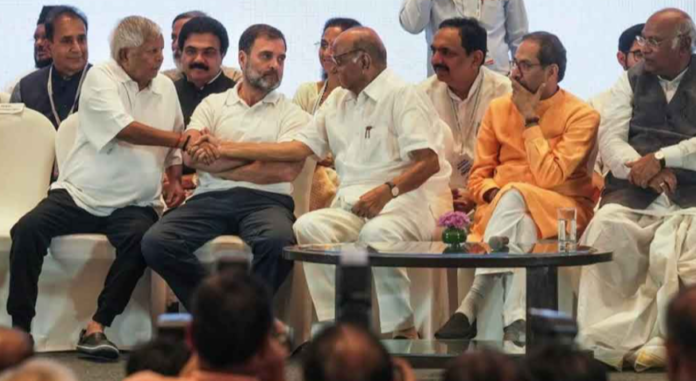
Amit Pandey
On March 3, 2024, the India Alliance, a coalition of opposition parties led by the Rashtriya Janata Dal (RJD), held a massive rally in Patna, the capital of Bihar, to appeal to the voters to vote on the issues of unemployment, justice and secularism in the upcoming Lok Sabha elections. The rally, dubbed the ‘Jan Vishwas Maharally’, was attended by thousands of supporters and workers of the alliance, which comprises the RJD, the Congress, the Samajwadi Party, the Left parties and several smaller parties. The rally was also graced by the presence of prominent leaders of the alliance, such as RJD president Lalu Prasad Yadav, Congress leader Rahul Gandhi, Samajwadi Party chief Akhilesh Yadav, CPI(M) general secretary Sitaram Yechury, CPI leader D. Raja, among others.
The rally was seen as a show of strength and unity by the India alliance, which aims to challenge the ruling National Democratic Alliance (NDA), led by the Bharatiya Janata Party (BJP), in the Lok Sabha elections. The rally was also seen as a platform to project RJD leader and former deputy chief minister Tejashwi Yadav as the chief ministerial candidate of the alliance for the next assembly elections in Bihar, which are likely to be held later this year. Tejashwi Yadav, the son of Lalu Prasad Yadav, has emerged as the face of the alliance and the main challenger to the incumbent chief minister Nitish Kumar, who recently ditched the RJD and joined hands with the BJP in a dramatic political turn of events.
The rally was also an opportunity for the alliance to highlight the achievements and promises of the RJD-led government, which was in power for less than three months before Nitish Kumar’s defection. The alliance claimed that the RJD government had fulfilled its promise of providing jobs to four lakh youths, and had initiated several welfare schemes and development projects for the people of Bihar. The alliance also accused the NDA government of betraying the mandate of the people, and of being anti-people, anti-poor and anti-secular. The alliance also vowed to protect the constitution and democracy from the threats posed by the BJP and its allies.
The rally was also a platform for the alliance to attack the BJP and its policies at the Centre and in the state. The alliance criticized the BJP for its failure to provide jobs, farmers’ income, women’s safety, education, health, and social justice to the people of the country. The alliance also slammed the BJP for its divisive and communal agenda and for its attempts to undermine the federal structure and the autonomy of the states. The alliance also accused the BJP of indulging in corruption, scams, and crony capitalism, and of misusing the institutions of democracy, such as the judiciary, the media, the CBI, and the ED, to harass and intimidate its opponents.
The rally was also a message to the public of Bihar, that the India alliance is the only alternative to the NDA, and that it represents the aspirations and interests of the people of the state. The alliance appealed to the people to vote for the alliance in the Lok Sabha elections and to give it a chance to form the next government in Bihar. The alliance promised to work for the development, welfare, and empowerment of the people of Bihar, and to uphold the values of secularism, socialism, and democracy. The alliance also assured the people that it will restore the dignity and pride of Bihar, and will make it a model state in the country.
The rally was a significant event in the political landscape of Bihar, as it demonstrated the strength and unity of the opposition parties, and their resolve to take on the BJP and its allies in the upcoming elections. The rally also boosted the morale and confidence of the alliance workers and supporters and generated enthusiasm and excitement among the voters. The rally also showcased the leadership and charisma of Tejashwi Yadav, who has emerged as the main contender for the chief minister’s post, and who has the potential to attract the youth, the backward classes, and the minorities to the alliance’s fold.
However, the rally also posed some challenges and questions for the alliance, such as the seat-sharing formula, the coordination and cooperation among the partners, the management of the internal differences and contradictions, and the counter-strategy to the BJP’s campaign and propaganda. The alliance also has to face the challenge of Nitish Kumar, who still enjoys some popularity and credibility among the people, and who has the support of the BJP, which is a formidable force in the state and the country. The alliance also has to deal with the challenge of Chirag Paswan, the son of the late LJP leader Ram Vilas Paswan, who has been trying to carve a niche for himself in state politics, and who has been critical of both the NDA and India alliance.
The rally was thus a crucial step for the Indian alliance, but not the final one. The alliance has to work hard and smartly to convert the rally’s momentum into electoral success and to fulfil the expectations and aspirations of the people of Bihar. The rally was a beginning, not an end, of the alliance’s journey to power.



Somebody essentially lend a hand to make significantly posts I might state That is the very first time I frequented your web page and up to now I surprised with the research you made to create this particular put up amazing Excellent job
I have been browsing online more than three hours today yet I never found any interesting article like yours It is pretty worth enough for me In my view if all website owners and bloggers made good content as you did the internet will be a lot more useful than ever before